
By Jorge A. Gil, DCEP
POWER VS ENERGY
The PUE original term was based on the power used by the IT equipment and the power used by the Facility systems/components that provide service to the IT equipment and the Computer Room.
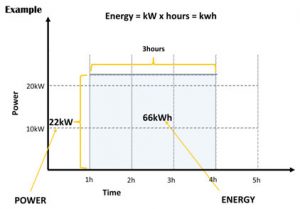
The reason for using energy instead of power is because it provides a more accurate picture of the status and the level of efficiency over a period of time. Power typically fluctuates and it can drive us to erroneous or inaccurate conclusions about the performance/efficiency of any equipment/system over time.
However power can help to give us an idea about the performance in a particular point in time, and helps to project scenarios over future system performance.
PUE CALCULATION
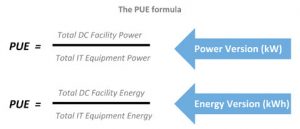
PUE RESULTED VALUE IS ALWAYS > 1.0
Resulted PUE values varies from 1.0 to infinity. As the value approaches 1.0 the better is the energy used by the systems/components of the Data Center Facility. In Figure 3 there are some references of PUE values and their level of efficiency.
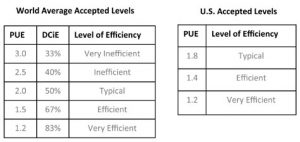
In order to understand PUE it is important to differentiate Data Center facilities equipment, according to its mission or purpose. They can be classified in two main groups: IT Equipment and Site Infrastructure systems.
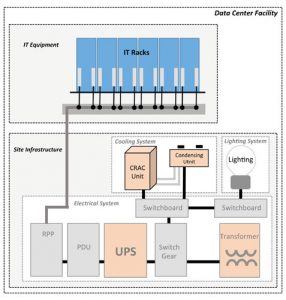
When we look at PUE basically we take a look at how efficient the Site Infrastructure that serves the IT Equipment is. As shown in Figure 5, PUE formula is graphically represented to give an idea of the systems involved.
As shown in Figure 5, PUE formula is graphically represented to give an idea of the systems involved. In Figure 5 we can easily see that the “Total DC Facility energy” will be represented as “IT Equipment energy” multiples. The value resulted from PUE calculation would be “IT Equipment energy” units, for example a PUE=2.0 would be 2 “IT Equipment energy” units or 2 times the “IT Equipment energy”. The same happens with PUE=1.5. It would be 1.5 times “IT Equipment energy”.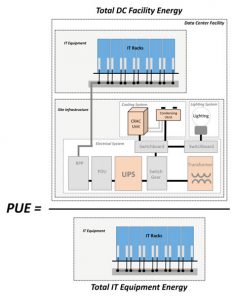
Figure 6 shows the representation of these examples’ values.
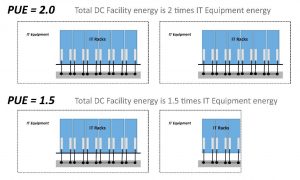
PUE gives an idea of magnitude about how much the Data Center Facility energy is by comparing it with the IT Equipment energy consumption. So it will show the Data Center Facility energy in terms of IT Equipment energy multiples. It makes a fair comparison, by contrasting the IT Equipment energy consumption against the Site Infrastructure energy consumption that was designed to provide different kinds of services (Cooling, Power, Lighting, Security, etc.) to the IT Equipment and to the Data Center’s mission. This approach has given the Data Center industry a race to benchmark every Data Center, and showcasing technologies and design approaches that makes improvement to Data Centers with the PUE in the spotlight. However, PUE is really meant to be used by a Data Center to measure its performance improvements, not to compare different Data Centers.
HOW TO USE PUE AS A WAY TO IMPROVE DATA CENTER ENERGY CONSUMPTION
PUE is a metric that can help not only to assess our current situation about the energy consumption but also to set future goals and easily follow up every improvement.
As a metric for Data Center Site Infrastructure it accounts for the energy consumption of:
All of these facility infrastructure components are considered to be accounted by the PUE, and the related energy can be tracked independently with the approach shown in the next pages.
A way to easily see the information resulted from PUE is representing it graphically like Figure 7.

In that figure PUE is initially decomposed by differentiating the part related to IT equipment (constant value) which always is 1, and the part related to Site Infrastructure (variable value) which is the area of opportunity for improvements or the optimization energy area.
In Figure 7, the PUE minimum theoretical value of 1 as the part related to IT equipment can also be noticed. In the real world PUE=1 can never be reached. PUE will be always > 1 and maybe the best it can get could be 1.0x and that would be a very exceptional number.
So the area of energy optimization will be the part of the PUE related to the Site Infrastructure trying to get the lesser possible number approaching to 1. That demonstrates that PUE is a metric designed as a KPI to target only Site Infrastructure energy performance. The part related to IT Equipment Energy is accounted as a constant value as a reference to contrast Site Infrastructure energy performance. We could say that IT Equipment Energy is treated as a “Black Box” for the PUE purposes. Therefore, PUE may hide inefficiencies in the IT Equipment.
PARTIAL PUE (PPUE) OF SITE INFRASTRUCTURE SYSTEMS/ COMPONENTS
Partial PUE can be used as a tool to make PUE a more precise tool in order to look deep down in every system of the Site Infrastructure for improvements. One of the uses of partial PUE is to measure one system that is part of the Site Infrastructure or it can go even further by decomposing a particular system. That gives a better picture in order to understand where the energy is
being drawn and how we can improve a component within a system.
Partial PUE can gives also a quick idea of how efficient a system/component is.
In the table 1 there is an example of Data Center facility energy consumption in 1 year.

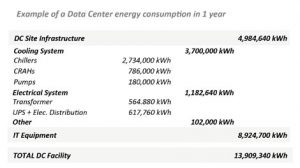
In the next example there will be partial PUE (pPUE) and PUE calculations from Table 1:
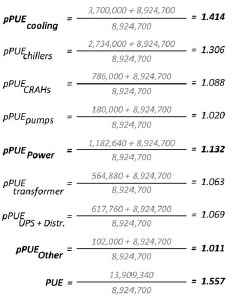
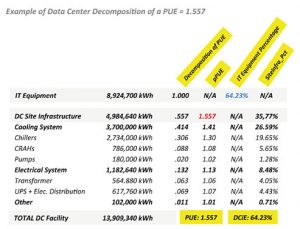
DECOMPOSING PUE
One of the advantages of pPUE is the ability to decompose PUE when looking for areas of improvement. That can be done by resting pPUE of any system/component minus 1, then you get the part of the PUE related to this system/component. Figure 10 is a graphical representation example of a decomposition of PUE using Table 1 data.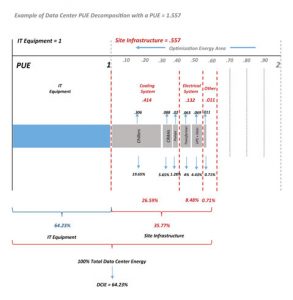
Table 2 shows more detail about the example of PUE decomposition. Figure 11-A and Figure 11-B are pie graphics from Table 2.
By decomposing the PUE it is possible to understand how every system/component affects PUE. It can also be represented in percentage. Here there is a set of formulas that help in decomposing PUE.
DCiE is the reciprocal of PUE, and is another way to look at Data Center energy efficiency. Basically DCiE is the portion of Total DC Facility Energy related to IT Equipment in percentage.
DCiE is a metric that can be used independently of PUE, however using these metrics together can give a more useful picture of Data Center Energy Consumption.
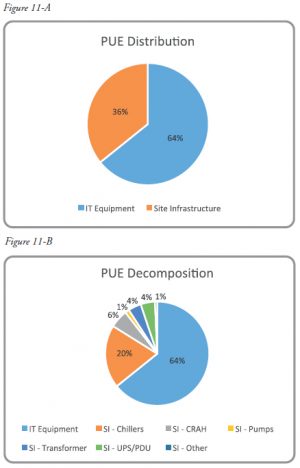
By decomposing the PUE it is possible to understand how every system/component affects PUE. It can also be represented in percentage. Here there is a set of formulas that help in decomposing PUE.
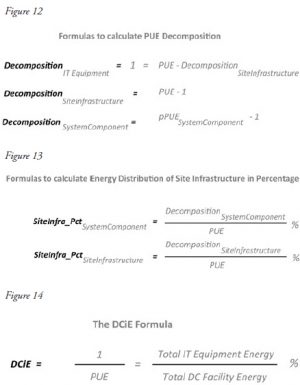
EXTRAPOLATING PUE
Another advantage of PUE when we look for energy efficiency improvements in terms of absolute energy consumption, is the easy way to extrapolate the resulted energy efficiency of any Data Center. PUE an be used to target a point of efficiency and compare it with the current PUE value, in order to see how much energy can be saved in kWh and also in financial terms. That is one of the most important aspects of PUE. As we treat IT Equipment energy as a constant value, we can effectively project Site Infrastructure improvements by estimating future PUE to later calculate the savings.
However it´s important to be careful in the way the improvements are made in order to not affect negatively the IT Equipment intake conditions (temp/cfm). Negatively affecting IT equipment intake conditions might have an important increase in IT Equipment Energy consumption causing a distortion of the IT Equipment energy (increased consumption) that will create a false improvement of PUE.
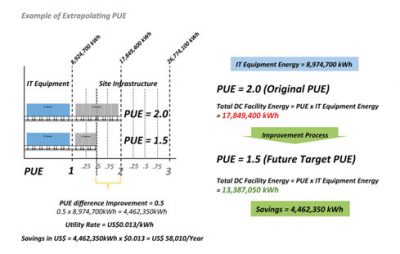
If the utility rate would be, for example, US$ 0,013 per kWh then the resulted savings would be US$ 58,010 in a year.
Those savings can be used to be applied to Site Infrastructure ROI, in order to justify the improvements.
CONCLUSION
It can be affirmed without any mistake that PUE is a metric related to Data Center Site Infrastructure. The more effort is put on optimizing the Site Infrastructure in terms of energy efficiency the more impact will be reflected on PUE. PUE is arguably the best quick way to get a first impression or initial idea about how energy efficient a Data Center is. Additionally if it is used in conjunction with partial PUE System/Component (pPUE) and PUE decomposition techniques, it can provide a more deep insight about what components consume more energy and therefore where the improvements should be made in order to generate better results. Tracking the PUE decomposition to keep a historical record would give Data Center operators and managers a powerful tool to follow up any improvement and could also be a tool to continuously monitor the energy performance of any system and component.
References
White Paper #49 – PUE: A comprehensive examination of the metric
White Paper #29 – ERE: A metric for measuring the benefit of reuse energy from a Data Center
Jorge A. Gil, DCEP is Principal at SERES, LLC. He can be reached at jagil@serestech.com.